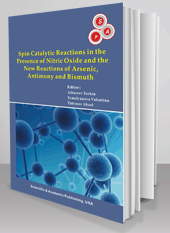Scientific & Academic Publishing
SAP is an open access publisher of journals covering a wide range of academic disciplines.
SAP is an open access publisher of journals covering a wide range of academic disciplines.

Description
Authors were discovered two new authors reactions Aibassov - Dorfman, Aibassov-Yuriev, and a new approach to finding the modification of 36 reactions and rearrangements: Atherton-Todd, Betti, Mannich, Doebner, Michaelis-Arbuzov, Allen, Milobendzky-Shulgin, Michaelis- Beckker, Raymond, Petasis, Passerini, Hantzsch, Kabachnic-Fields, Ugi.
The authors proposed two equations Klopman-Dorfman-Aibassov and Nernst-Aibassov for solving the spin and magnetic effects in catalysis.
The book will be useful for engineers and chemists working in physical chemistry for teachers and students in related disciplines, as well as for researchers and graduate students interested in physical chemistry and catalysis.
Table of Contents
Introduction
Part I - Spin Catalytic Reactions in Presence Nitric Oxides
1. Oxygen Nitrogen (I) Compounds
2. Oxygen Nitrogen (II) Compounds
3. Oxygen Nitrogen (III) Compounds
4. Oxygen Nitrogen Compounds (IV)
5. Oxygen Nitrogen Compounds (V)
6. Catalytic Oxidation of Organic and Inorganic Compounds with Oxygen in the Presence of Nitrogen Oxides
6.1. Oxidation of Alcohol with Oxygen in the Presence of Nitrogen Oxides
6.2. Oxidative Iodination of Aromatic Hydrocarbons
6.3. Oxidative Bromination of Aromatic Hydrocarbons
6.4. Oxidative Bromination of Acetophenone
6.5. Catalysis Nitrogen Oxides Bismuth Sulfide Oxidation with Oxygen
6.6. Oxidizing Properties of Nitric Oxide (II)
6.7. Reduction of Nitrogen Oxides with Hydrogen Sulfide in the Solution
6.8. Reduction of Nitrogen Oxides by Carbon Monoxide
Conclusions
Appendix
REFERENCES
Part II - New Reaction of Arsenic, Antimony and Bismuth
1. New Reaction of Arsine with Alkohols in Presence of Metal Complexes
2. Possible New Reaction of Arsine
3. The New Aibassov’s - Yuriev's Reaction Transformation of Furan in Its Analogs - Phosphorane, Arsanol, Stibinol and Vismutol
4. A New Modification Michaelis-Arbuzov, Allen Milobendzky-Shulgin, Michaelis-Becker and Raymond Reactions with Organic Compounds Arsenic, Antimony and Bismuth
5. Search for New Three-, Four-Component Petasis, Passerini, Hantzsch, Kabachnic-Fields, Ugi Reactions with Organic Compounds of Phosphorus, Arsenic, Antimony and Bismuth
6. New Modifications Bart, Béchamp, Mayer, Rosenmund, Scheller, Sherlyn-Braz Reactions with Halides of Arsenic, Antimony and Bismuth
7. A New Approach to Modification of Rearrangements in Metallorganic Chemistry of Phosphorus, Arsenic, Antimony and Bismuth
8. New Modifications Bart, Béchamp, Mayer, Rosenmund, Scheller, Sherlyn-Braz Reactions with Halides of Arsenic, Antimony and Bismuth
9. Search for New Three-, Four-Component Petasis, Passerini, Hantzsch, Kabachnic-Fields, Ugi Reactions with Organic Compounds of Phosphorus, Arsenic, Antimony and Bismut
10. Search for New Opportunities Modification Raschig, Schiff, Andrusov, Hofmann, Colbe and Delepine Reactions
11. A New Approach Modification Reactions Atherton-Todd, Betti, Mannich and Doebner with of Arsine, Stibine and Bismuthine in Organometallic Chemistry
12. New Approach to Finding Modifications Hofmann-Martius, Pistschimuka, Ciamician-Dennstedt, Chapman, Steiglitz, Robev Rearrangements with Halides and Hydrides of Arsenic, Antimony and Bismuth
13. A New Approach to Explaining the Oscillatory Oxidation of Arsenites, Stibnites and Vismutinites Using Magnetic Method
14. Magnetic and Relativistic Effects in Uranium Catalysts and the Movement of Charged Particles under the Effect of a Uniform Electric Field and Uniform Magnetic Field
15. New of the Microsphere Magnetic Catalyst of the Thorium-Uranium Catalyst Containing As and Bi for Fischer-Tropsch Synthesis
16. The New Formulation of the Principle of the Periodic Table of the Elements
17. Derivation of the Equation Nernst-Aibassov in a Magnetic Field
18. Study of Changes in the Thermodynamic Functions in a Magnetic Field
Conclusions
REFERENCES